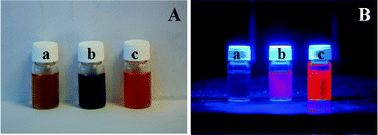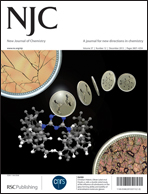Eu(iii)-coupled graphene oxide as a luminescent material†
Abstract
A graphene–inorganic hybrid material has been fabricated by coupling Eu(III) complexes onto graphene oxide (GO) (denoted as Eu-GO hereafter). Successful coupling has been verified by 1H NMR, CHN elemental analysis, inductively coupled plasma-atomic emission spectroscopy (ICP) for Eu3+ content, and Fourier transform infrared (FTIR) spectroscopy. UV-vis measurements of a dilute dispersion of Eu-GO in ethanol reveal the characteristic absorption of Eu(III) complexes, which gives further proof of the successful coupling. The composites display strong luminescence, more durable emission decay, enhanced photoluminescent stability, and improved thermal stability in comparison with the isolated complexes, due to interactions of the complexes with the GO.


 Please wait while we load your content...
Please wait while we load your content...